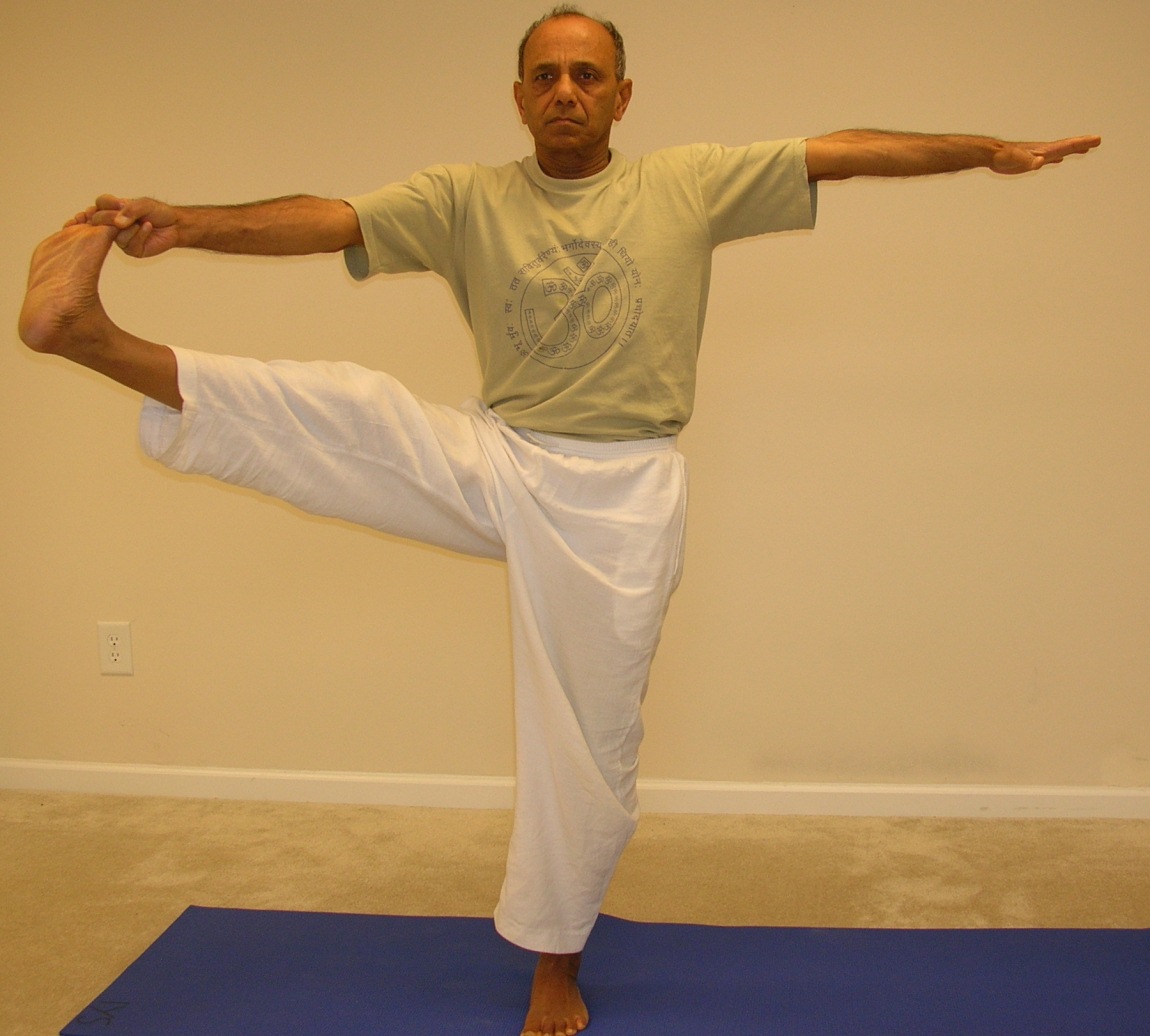
Hasta-padasana
hasta-pādāsana (हस्त-पादासन) (hand to foot pose), also known as utthita hasta-pādāṅguṣṭhāsana (उत्थित हस्त-पादाङ्गुष्ठासन) (Extended hand to toe pose) is an intermediate level one-leg balancing pose. Like most other standing balancing poses, it develops strength in the legs, improves focus, concentration, balance and stability. We’ll practice a few different variations of the pose:
- With support of the wall, using a strap
- Without wall support, using the strap
- Without wall support, and without the strap
- Revolving variation of the asana
My friend, Maanasa, has graciously agreed to demonstrate this asana sequence. I hope you will enjoy practicing with the video.
hasta-pādāsana, with wall support, using a strap
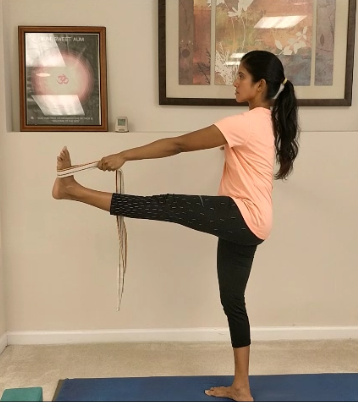
Hastapada-wall-strap-front
Step-by-step
- Stand perpendicular to the wall, about one arm length away, with the left side facing the wall.
- Place the left hand on the wall for support. Position the right foot in the strap, holding the strap very close to the foot with the right hand.
- While doing these leg stretches, try to keep the torso upright, without tilting the body in any direction.
- Keeping the left leg grounded, slowly, begin to stretch the right leg straight and lift it up in front of the body. Make the effort to keep the knee straight and lift the leg as high as it can comfortably go. If you feel tightness and discomfort in the hamstrings, feel free to bend the knee slightly.
- Tuck the navel in towards the spine, holding the abdominal muscles firm.
- Maintain your gaze fixed at a spot in front. Hold the pose for about five breaths.
- Now, begin to swing the leg slowly to the far right, trying to bring the leg in line with the two shoulders.
- Maintain a gentle effort to lift the leg higher while keeping it straight.
- Hold this position for about five breaths. Slowly, bring the leg back straight in front. Pause there briefly and bring the leg slowly down. Relax for a few breaths.
- Turn around and repeat the above steps on the other side.
hasta-pādāsana, with wall support, without the strap
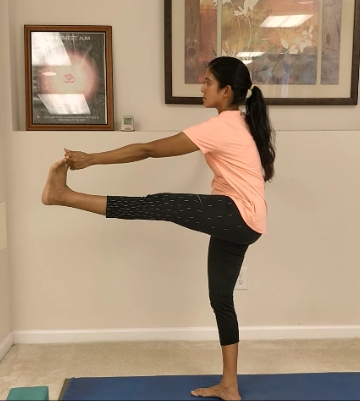
Hasta-pada-wall-front
In this variation, we’ll repeat the above moves, still using the wall for support but without the use of the strap.
Step-by-step
- Stand perpendicular to the wall, about one arm length away, with the left side facing the wall.
- While doing these leg stretches, try to keep the torso upright, without tilting the body in any direction.
- Place the left hand on the wall for support. Lift the right foot up and hold the big toe of the right foot with the right hand.
- Slowly, begin to stretch the leg straight and lift it up in front of the body. Make the effort to keep the knee straight and lift the leg as high as it can comfortably go. If you feel tightness or any kind of discomfort in the hamstrings, feel free to bend the knee slightly.
- Tuck the navel in towards the spine, holding the abdominal muscles firm.
- Maintain your gaze fixed at a spot in front. Hold the pose for about five breaths.
- Now, begin to swing the leg slowly to the far right, trying to bring the leg in line with the two shoulders. Maintain a gentle effort to lift the leg higher while keeping it straight.
- Hold this position for about five breaths. Slowly, bring the leg back straight in front. Pause there briefly and bring the leg slowly down. Relax for a few breaths.
- Turn around and repeat the above steps on the other side.
hasta-pādāsana (hand-to-foot pose)
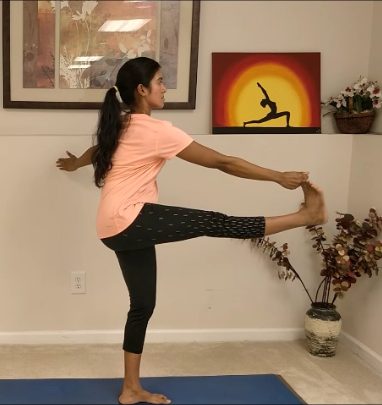
Hasta-pada-front
This is the main variation of the pose wherein we don’t use either the wall or the strap for support.
Step-by-step
- Begin by coming to a standing posture on the mat.
- Shift your weight onto your left foot and press it firmly into the floor. Place your left hand on your hip and slowly bring the right foot up with the knee bent, holding the big toe with the middle and index fingers of the right hand.
- Keeping the left leg grounded, slowly straighten the right leg as much as you comfortably can, keeping the leg straight in front. Try to lift the leg up until it is parallel to the floor or even slightly higher. Tuck the navel in towards the spine, holding the abdominal muscles firm.
- Maintain your gaze fixed at a spot in front.
- If you are not able to stretch the leg straight in front, try to keep it at any angle that feels comfortable.
- Carefully take the right leg out to the right-hand side, turning the head to look over the left shoulder, left hand on left hip. Try to maintain a smooth and even breathing pattern.
- Hold the final pose for five to ten breaths.
- Bring the right leg back in front of you, still raised from the floor. Keeping the navel drawing in gently to support the back, and the front thigh strong, slowly release the hand away from your foot, keeping the leg extended in front of you. Keep both hands on your hips. Try not to lean back.
- Slowly lower the leg and come back to the standing position and relax for a few breaths.
- Repeat the above steps on the other side.
Standing head-to-knee variations
Variation 1
In this variation we try to emulate the seated head-to-knee pose (janu-shirshasana) while in the standing leg stretch balance. While holding the foot with both hands and trying to keep the leg straight in front, try to bend over the stretched leg and bring the chest close to the thigh. Hold the pose for about five breaths, then slowly release the leg down and relax.
Variation 2
In this variation, we place the foot on the top of a chair or any other raised platform (window-sill for example). Try to straighten the knee and then bend over the stretched leg, stretching the arms along the leg, finally holding the sole of the foot with both hands. Try to bring the chest close to the thigh. Hold the pose for about five breaths, then slowly release the leg down and relax.
Parivritta (revolving) hasta-pādāsana with wall support
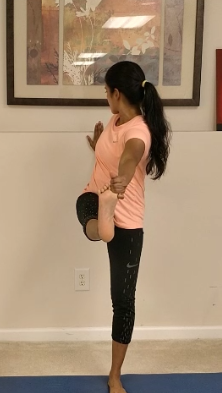
Hasta-pada-revolving-wall
This variation is very similar to the hasta-pādāsana with wall support described earlier. The main difference is that we hold the left foot with the right hand and then try to stretch the leg straight.
Step-by-step
- Stand with the back facing the wall, about one arm length away.
- While doing these leg stretches, try to keep the torso upright, without tilting the body in any direction.
- Place the left hand on the wall for support. Lift the left foot up and hold the big toe with the right hand.
- Slowly, begin to stretch the leg straight and lift it up in front of the body. Make the effort to keep the knee straight and lift the leg as high as it can comfortably go. If you feel tightness or any kind of discomfort in the hamstrings, feel free to bend the knee slightly.
- If comfortable, roll the left shoulder back and look over that shoulder to create a nice twisting experience.
- Hold the pose for about five breaths. Slowly, bring the leg down. Relax for a few breaths.
- Turn around and repeat the above steps on the other side.
Parivritta (revolving) hasta-pādāsana
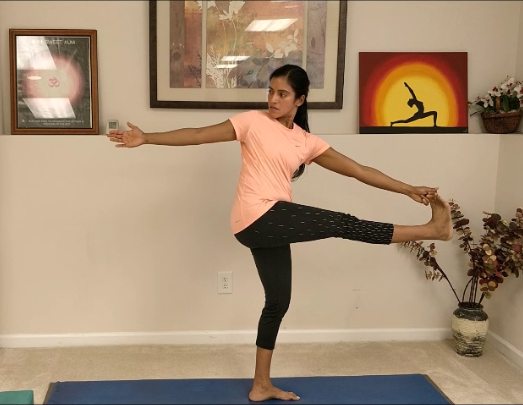
Hasta-pada-revolving
This is the main variation of the revolving hand-to-foot asana. It is identical to the variation given above except that we’ll repeat the above steps without the wall support.
Benefits:
- Improves balance, concentration, patience and determination
- Stronger and tighter abdominal muscles
- Stronger legs, especially the thigh quads and hamstrings
- Increases the flexibility of the hamstring and sciatic nerves
- Strengthens the shoulders
- Stretches the lower back
Contraindications
Avoid this pose if you have pain in the lower back or have a leg or ankle injury.
can pranayama be done at night
At night practice gentle, deep breathing pranayamas at least .5 hour before going to bed. Avoid intense practices like kapalabhati and bhastrika.